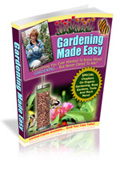Welcome to Gardening Guide
Indoorgardeningsupplies Article
 . For a permanent link to this article, or to bookmark it for further reading, click here.
. For a permanent link to this article, or to bookmark it for further reading, click here.
The art of indoor gardening
from:Indoor gardening is an art, but even those with a ‘black thumb’ can make a
success of it with the right type of plants. Indoor gardening serves a
number of purposes: beautification, purification and source of activity and
relaxation. Many persons are unable to keep an outdoor garden because they
live in apartment buildings or the climate just is not conducive to outdoor
gardening.
To get the best out of your indoor gardening efforts, the following tips
will come in handy:
• Select the right type of plants
Some indoor plants are easier to care for than others, so depending on the
time you have available this is a serious consideration for indoor
gardening. The best plants to use indoors are foliage plants because they
are generally easy to maintain since they do not require a lot of attention.
• Types of containers
The container used for indoor plants must be drainable, that is, water
shouldn’t sit in there after the plants are watered. If the pots do not
allow drainage some plants will die as the roots will rot, plus mosquitoes
will use the still water as a breeding ground. Also, some indoor plants need
very little water such as cactus.
• Temperature control
Humidity and temperature control are also vital to the health of indoor
gardening. House plants need a certain level of humidity to grow well.
Humidity can be maintained by using a humidifier, but you can also help by
spraying water on the leaves in the morning. It is not advisable to do this
at night since there is less evaporation and this can result in the plant
rotting. Try to maintain a temperature range of between 65 – 75 degrees
Fahrenheit. Most plants can stand fluctuation of between 8 – 10 degrees
daily; anything greater or lesser can result in poorly growing plants. If
your plant leaves begin to turn yellow it is an indication that the
temperature is too low; if the plants fail to strive the temperature may be
too high.
• Arrange for adequate lighting
Most plants need some amount of sunlight to strive, however this is not
always possible. If you are unable to provide enough natural light for your
indoor gardening needs, consider installing artificial lighting.
• How to water plants, when and how often
Watering indoor plants calls for observation of certain rules. These
include:
• try to use room temperature water so as not to shock the plants
• Wet the soil and allow to drain so that it does not become soggy
• Do not over water the plants
Indoor gardening, also commonly known as container gardening is a great way
to brighten a cold winter’s day.
Indoorgardeningsupplies News



